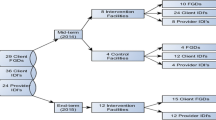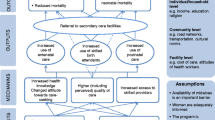Abstract
Objective
In recent decades, governments around the globe have been under pressure to create more efficient and effective health care systems. Research shows, particularly in middle- and low-income countries, that many of these neo-liberal policies that have been enacted have had a largely negative effect with regard to equitable health services for lower-income populations and dignified working conditions for health providers. In this paper we highlight recent reforms in health care in Canada, focusing on formal care during pregnancy and childbirth, and compare these to parallel developments in two Nordic countries–Finland and Iceland.
Method
We draw upon secondary data sources and primary research findings.
Results
Our comparative analysis pays close attention to barriers in access to primary care services across the childbearing period for lower-income women in the three countries, as well as the factors that create poor working conditions for the predominantly female maternity care labour force.
Discussion
As Canada struggles to deal with the crisis in its maternity care system, it could learn from developments in Finland and Iceland that promote teamwork among primary health care professionals and high-quality care for lower-income populations.
Résumé
Objectif
Depuis plusieurs décennies, un peu partout dans le monde, on pousse les gouvernements à créer des systèmes de santé plus efficients et efficaces. La recherche, particulièrement dans les pays à faible revenu et à revenu intermédiaire, montre que bon nombre des politiques néolibérales qui ont ainsi été édictées ont nui dans une large mesure à l’équité des services de santé accessibles aux populations à faible revenu et à la dignité des conditions de travail des dispensateurs de soins de santé. Dans cet article, nous examinons les réformes récentes dans les soins de santé au Canada, notamment dans les soins réglementés offerts pendant la grossesse et l’accouchement, et nous les comparons aux changements apportés en parallèle dans deux pays nordiques: la Finlande et l’Islande.
Méthode
Nous avons fait appel à des sources de données secondaires et à des résultats de recherche primaires.
Résultats
Notre analyse comparative porte spécifiquement sur les obstacles à l’accès aux services de soins de première ligne pendant toute la période d’activité génitale pour les femmes à faible revenu dans les trois pays à l’étude, ainsi que sur les facteurs responsables des piètres conditions de travail de la main-d’œuvre (essentiellement féminine) des soins de maternité.
Discussion
Le Canada, aux prises avec la crise de son système de soins de maternité, pourrait tirer des enseignements de l’expérience de la Finlande et de l’Islande, qui favorisent le travail d’équipe entre les divers professionnels de la santé primaire et veulent assurer des soins de haute qualité pour les populations à faible revenu.
Similar content being viewed by others
References
Sen A. Health: Perception versus observation. BMJ 2002;324:860–61.
Whitehead M, Dahlgren G, McIntyre D. Putting equity centre stage: Challenging evidence-free reforms. Int J Health Serv 2007;37(2):353–61.
Esmail N, Walker M. How Good is Canadian Health Care? 2005 Report. Vancouver, BC: The Fraser Institute, 2005.
Denton M, Zeytinoglu I, Davies S. Working in clients’ homes: The impact on the mental health and well-being of visiting home care workers. Home Health Care Serv Q 2002;21(1):1–27.
Denton M, Zeytinoglu I, Davies S, Lian J. Job stress and job dissatisfaction of home care workers in the context of health care restructuring. Int J Health Serv 2002;32(2):327–57.
Armstrong P, Armstrong H, Bourgeault I, Choiniere J, Lexchin J, Mykhalovskiy E, et al. Market principles, business practices and health care. Int J Can Studies 2003;28:13–38.
Aronson J, Sammon S. Practice amid social service cuts and restructuring: Working with the contradictions of small victories. Can Soc Work Rev 2000;17(2):167.
Bezanson K, Luxton M (Eds.). Social Reproduction: Feminist Political Economy Challenges Neo-Liberalism. Montreal and Kingston: McGill-Queen’s University Press, 2006.
Mackintosh M, Koivusalo M. Commercialisation of Health Care. Basingstoke, UK: Palgrave Macmillan, 2005.
Conrad P, Leiter V. Medicalization, markets and consumers. J Health Soc Behav 2004;45:158–76.
Van Teijlingen E. A critical analysis of the medical model as used in the study of pregnancy and childbirth. Sociol Res Online 2005;10(2). Available online at: https://doi.org/www.socresonline.org.uk/10/2/teijlingen.html (Accessed December 13, 2006).
DeVries R, Benoit C, Van Teijlingen E, Wrede S (Eds.). Birth by Design. London: Routledge, 2001.
Benoit C, Wrede S, Bourgeault I, Sandall J, Van Teijlingen E, DeVries R. Understanding the social organisation of maternity care systems. Sociol Health Illness 2005;27(6):722–37.
Wrede S, Benoit C, Bourgeault I, Van Teijlingen E, Sandall J, DeVries R. Decentred comparative research. Soc Sci Med 2006;63(11):2986–97.
Naylor N. Private Practice, Public Payment: Canadian Medicine and the Politics of Health Insurance, 1911–1966. Montreal, QC: McGill-Queen’s University Press, 1986.
Olsen G. The Politics of the Welfare State: Canada, Sweden and the US. Toronto, ON: Oxford University Press, 2002.
Canadian Institute for Health Information. Health Care in Canada. Ottawa, ON: CIHI, 2005.
Organisation for Economic Co-operation and Development. Source OECD Health Data. Geneva: OECD, 2008.
Canadian Perinatal Service System. Canadian Perinatal Health Report. Ottawa: Health Canada, 2003;55.
Wrede S, Benoit C, Sandall J. The state and birth/the state of birth: Maternal health policy in three countries. In: DeVries R, Benoit C, Van Teijlingen E, Wrede S (Eds.), Birth by Design, London: Routledge, 2001;28–50.
Benoit C, Heitlinger A. Women’s health care work in comparative perspective. Soc Sci Med 1998;47(8):1101–11.
O’Neil J, Kaufert P. The politics of obstetric care: The Inuit experience. In: Mitchinson W, Bourne P, Prentice A, Cuthbert Brandt G, Light B, Black N (Eds.), Canadian Women: A Reader. Toronto, ON: Harcourt Brace, 1996;416–29.
Bourgeault I, Benoit C, Davis-Floyd R (Eds.). Reconceiving Midwifery. Montreal-Kingston: McGill-Queen’s University Press, 2004.
Wen S, Mery L, Kramer M, Jimenez V, Trouton K, Herbert P, et al. Attitudes of Canadian women toward birthing centres and midwifery care for childbirth. CMAJ 1999;161(6):708–9.
Harvey S, Rach D, Stainston M, Jarrell J, Brant R. Evaluation of satisfaction with midwifery care. Midwifery 2002;18:260–67.
Benoit C, Westfall R, Treloar A, Phillips R, Jansson SM. Social factors linked with postpar-tum depression. J Mental Health 2007;16(6):719–30.
Peterson W, Medves JM, Davies BL, Graham I. Multidisciplinary collaborative maternity care in Canada: Easier said than done. J Obstet Gynaecol Can 2007;29(11):880–86.
Canadian Institute for Health Information. Giving Birth in Canada: A Regional Profile. Ottawa: CIHI, 2004.
Canadian Institute for Health Information. Giving Birth in Canada: Regional Trends from 2001–2002 to 2005–2006. Ottawa: CIHI, 2007.
Leeb K, Baibergenova A, Wen E, Webster G, Zelmer J. Are there socio-economic differences in Caesarean section rates in Canada? Healthcare Policy/Politiques de Santé 2005;(1):48–54.
Canadian Perinatal Surveillance System. Perinatal Health Indicators for Canada. Ottawa: Health Canada, 2000.
Wrede S. Decentering Care for Mothers. Åbo: Åbo Akademi University Press, 2001.
Organisation for Economic Co-operation and Development. OECD Health Data 2008. Frequently Requested Data. Infant Mortality Rate. Available online at: https://doi.org/www.oecd.org/document/16/0,3343,en_2649_34631_208 5200_1_1_1_1,00.html; http://www.oecd.org/dataoecd/35/19/35027658.xls (Accessed August 14, 2005).
United Nations Development Programme. Human Development Programme Report, 2007/2008. New York: Palgrave Macmillan, 2008;281.
Statistics Iceland. Wages, Income and Labour Market. Statistical Series 2008;4(April 11). Available online at: https://doi.org/www.hagstofa.is/ lisalib/getfile.aspx?ItemID=8012 (Accessed August 10, 2008).
The Icelandic Birth Registration, 2006. Available online at: https://doi.org/www4.landspitali.is/lsh_ytri.nsf/pages/kven_0114/$file/faedingarskraningarskyrsla_2006.pdf (Accessed August 10, 2008).
STAKES, Finnish Birth Register data. Available online at: https://doi.org/www.stakes.fi/FI/Tilastot/Aiheittain/ Lisaantyminen/synnyttajat/index.htm (Accessed August 5, 2008).
Canadian Institute for Health Information. Health Indicators. Ottawa: CIHI, 2008.
Kojo-Austin H, Malin M, Hemminki E. Women’s satisfaction with maternity health care services in Finland. Soc Sci Med 2003;37:633–38.
Henriksson L, Wrede S, Burau V. Understanding professional projects in welfare service work. Gender, Work and Organization 2006;14(2):174–92.
Gissler M, Meriläinen J, Vuori E, Hemminki E. Register based monitoring shows decreasing socioeconomic differences in Finnish perinatal health. J Epidemiol Community Health 2003;57:433–39.
Organisation for Economic Co-operation and Development. OECD Health Data 2007. Available online at: https://doi.org/www.oecd.org/document/16/0,3343,en_2649_37407_2085200_1_1_1_3740 7,00.html (Accessed October 7, 2007).
Finnish Ministry of Social Affairs and Health. Seksuaali–ja lisääntymisterveyden edistäminen. Toimintaohjelma 2007–2011. Promotion of Sexual and Reproductive Health Action Programme 2007–2011. Helsinki, 2007.
Law on the Changes of the Public Health Act (Laki kansanterveyslain muuttamisesta), 2005.
Finnish Ministry of Social Affairs and Health. The New Health Care Act. Memorandum of the Working Group Preparing the Health Care Act. Helsinki, 2008.
Halldórsson M. Health Care Systems in Transition: Iceland. European Observatory on Health Systems and Policies. Copenhagen: WHO, 2003.
Sigurgeirsdóttir S. Health Policy and Hospital Mergers: How the Impossible became Possible. Reykjavík: Háskólaútgáfan, 2006.
Kristjánsdóttir H. Allt vegna fóstursins. Afleidingar ómskodunar (All for the unborn child. Consequences of screening). In: Jónsson ÓP, Jónsdóttir AÓ (Eds.), Sjúkdómsvaeding (Medicalisation), Reykjavík: Fraedslunet Sudurlands, Sidfraedistofnun, Háskólaútgáfan, 2004.
Sigurdsson JA. The GP’s role in maternity care. Scand J Primary Care 2003;21:65.
Bjarnadóttir RI, Gardarsdóttir G, Smárason AK, Pálsson GI (Eds.). faedingarskráningunni (The Icelandic Birth Registration). Kvennadeild og Barnaspítali Hringsins. Landspítali-Háskólasjúkrahús (Landspitali University Hospital), 2006.
Gottfredsdóttir H. Breyttar áherslur í medgongu-vernd í ljósi nýrra adferda til fósturgreiningar og skimunar (Changes in maternal care in the light of new methods for prenatal screening). In: Jónsdóttir H (Ed.), Frá innsaei til inngripa: Thekkingarthroun í hjúkrunar-og ljósmódurfrae-di. Reykjavík: Hid íslenska Bókmenntfélag, 2006.
Ólafsdóttir ÓA. Breytingar og thróun í námi í ljósmódurfraedi (Changes and development in the education of midwifery). Ljósmaedrabladid (Journal of Midwives) 1995;73(2):14–17, 20–29.
Bjarnadóttir R. No correlation between rates of caesarean section and perinatal mortality in Iceland? Laeknabladid (Icelandic Medical Journal) 2006;91:191–95.
Association of Icelandic Midwives. Available online at: https://doi.org/www.ljosmodir.is/Felag/ (Accessed July 31, 2008).
Author information
Authors and Affiliations
Corresponding author
Rights and permissions
About this article
Cite this article
Wrede, S., Benoit, C. & Einarsdottir, T. Equity and Dignity in Maternity Care Provision in Canada, Finland and Iceland. Can J Public Health 99 (Suppl 2), 16–21 (2008). https://doi.org/10.1007/BF03403799
Published:
Issue Date:
DOI: https://doi.org/10.1007/BF03403799




